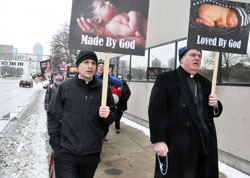‘Conversion begins with seeing
things
as they
are’
Archbishop Tobin points to youthful signs of hope at Jan. 25 Roe commemoration Mass

Father John Hollowell, left, and Archbishop Joseph W. Tobin pray the rosary on Jan. 25 while leading more than 400 pro-life supporters in a march up and down several blocks of Meridian Street in Indianapolis. The march and Mass at SS. Peter and Paul Cathedral that preceded it took place to commemorate the 40th anniversary of the Supreme Court decisions that legalized abortion in the United States in 1973. (Photo by Sean Gallagher)
By Sean Gallagher
Abortion on demand became the law of the land when the U.S. Supreme Court handed down the Roe v. Wade and Doe v. Bolton decisions on Jan. 22, 1973.
Forty years later, SS. Peter and Paul Cathedral in Indianapolis was filled with more than 700 worshippers—many of whom were born in the years that followed those decisions. They prayed that the Gospel of Life might overcome the culture of death to which the abortion license has greatly contributed.
The Jan. 25 Mass at the cathedral was the centerpiece of the third annual Local Solemn Observance of Roe v. Wade organized by the archdiocesan Office of Pro-Life Ministry. (See a photo gallery here)
Following the march, pro-life and chastity presentations were given in the cathedral by Jason Adams, a theology teacher at St. Theodore Guérin High School in Noblesville, Ind., in the Lafayette Diocese, Gabrielle Neal, director of the archdiocese’s Refugee Resettlement program, and Branden Stanley, a young adult member of Our Lady of the Most Holy Rosary Parish in Indianapolis.
The Mass took place on the feast of the Conversion of St. Paul and at the same time that hundreds of youths and young adults from across central and southern Indiana participated in the annual March for Life in Washington. (Related: Photos from the young adult pilgrimage to Washington, D.C.)
Archbishop Joseph W. Tobin, the principal celebrant and homilist at the Mass in Indianapolis, said that “conversion begins with seeing things as they are.”
“The commemoration of the Supreme Court decisions of 40 years ago is a call for our nation to see things as they really are,” Archbishop Tobin said.
He cited statistics to demonstrate this reality—approximately 55 million abortions since 1973 and one quarter of all pregnancies ending in abortion.
“Fifty-five million,” Archbishop Tobin repeated. “[That’s the] combined population of New York and California [or] the entire population of the country of Italy or France.”
He later said that the “coarsening of human sensibilities and the distortions of moral compasses” connected to abortion have contributed to the advancement of euthanasia and other forms of violence in society.
“We cannot be surprised by these developments,” Archbishop Tobin said, “since a culture that allows parents to kill their children will certainly allow children to kill their parents.
“We must ask ourselves to what extent the coarsening of our souls leads us to tolerate even what is unacceptable—the elimination of the unborn, the destruction of the handicapped, the dispatch of the elderly, the slaughter of human beings in movie theaters, elementary schools and college campuses.”
Despite the shadows cast across society in the past 40 years since the Roe and Doe decisions, Archbishop Tobin said that there are reasons for hope.
He noted that both women behind the anonymous names of “Roe” and “Doe” later changed their minds about abortion and now consider themselves pro-life.
He also mentioned that the late Dr. Bernard Nathanson, a prime advocate for the legalization of abortion in the years leading up to the 1973 decisions, later became horrified by the procedure and also became a pro-life activist.
More broadly, however, Archbishop Tobin saw the youthfulness of the pro-life movement as the greatest sign of hope.
“The majority of young people express themselves as being pro-life—a generation that Cardinal [Timothy M.] Dolan of New York refers to as the ‘sonogram generation,’ ” Archbishop Tobin said. “They’ve seen the pictures that their parents had taken of them while they were still in their mothers’ wombs. The humanity of that image cannot help but leave an impact on young, honest minds. They recognize what is carried in the womb is a distinct human being.”
Jane Hopwood, 54, a member of St. Paul the Apostle Parish in Greencastle, attended the Mass. Like the archbishop, she found encouragement in seeing so many young people at the pro-life Mass.
“It’s very hopeful because they are our next generation,” Hopwood said. “Hopefully, they will be a generation that will have a better grasp on the sanctity of life than this generation has.”
One of the young people at the Mass was Adriana Perez, a member of St. Philip Neri Parish in Indianapolis and an eighth-grade student at her parish’s school.
Speaking prior to the Mass, she looked forward to taking the pro-life message to the streets afterward and hoped that those who saw her and the other hundreds of marchers would embrace the Gospel of life.
“They should be against abortion and try to help out people who are [considering it] by giving them other options, like adoption,” Adriana said.
Joining Adriana at the Mass and march were Bobbie Wagner and Maggie Bruns, freshmen at the Oldenburg Academy of the Immaculate Conception in Oldenburg and members of St. Michael Parish in Brookville.
“I didn’t know that this many people would be out here. But they all want to make a difference. It’s really cool,” said Bobbie while walking down a Meridian Street sidewalk and holding a sign that showed an infant and the message, “Loved by God.”
“It’s really amazing,” added Maggie of the Mass and march. “There are a lot of people who care about [the pro-life message]. They think about it instead of ignoring the gift of life.” †
